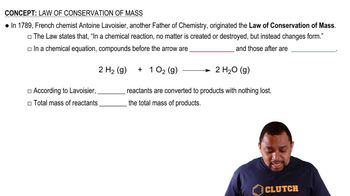Vanillin, the dominant flavoring in vanilla, contains C, H, and O. When 1.05 g of this substance is completely combusted, 2.43 g of CO2 and 0.50 g of H2O are produced. What is the empirical formula of vanillin?

An element X forms an iodide (XI3) and a chloride (XCl3). The iodide is quantitatively converted to the chloride when it is heated in a stream of chlorine: 2 XI3 + 3 Cl2 → 2 XCl3 + 3 I2 If 0.5000 g of XI3 is treated with chlorine, 0.2360 g of XCl3 is obtained. (a) Calculate the atomic weight of the element X. (b) Identify the element X.
 Verified step by step guidance
Verified step by step guidance
Verified video answer for a similar problem:
Key Concepts
Stoichiometry

Molar Mass

Conservation of Mass

An organic compound was found to contain only C, H, and Cl. When a 1.50-g sample of the compound was completely combusted in air, 3.52 g of CO2 was formed. In a separate experiment, the chlorine in a 1.00-g sample of the compound was converted to 1.27 g of AgCl. Determine the empirical formula of the compound.
A method used by the U.S. Environmental Protection Agency (EPA) for determining the concentration of ozone in air is to pass the air sample through a 'bubbler' containing sodium iodide, which removes the ozone according to the following equation: O31g2 + 2 NaI1aq2 + H2O1l2¡ O21g2 + I21s2 + 2 NaOH1aq2 (a) How many moles of sodium iodide are needed to remove 5.95 * 10-6 mol of O3?
A method used by the U.S. Environmental Protection Agency (EPA) for determining the concentration of ozone in air is to pass the air sample through a 'bubbler' containing sodium iodide, which removes the ozone according to the following equation: O31g2 + 2 NaI1aq2 + H2O1l2¡ O21g2 + I21s2 + 2 NaOH1aq2 (b) How many grams of sodium iodide are needed to remove 1.3 mg of O3?
The fat stored in a camel's hump is a source of both energy and water. Calculate the mass of H2O produced by the metabolism of 1.0 kg of fat, assuming the fat consists entirely of tristearin 1C57H110O62, a typical animal fat, and assuming that during metabolism, tristearin reacts with O2 to form only CO2 and H2O.
